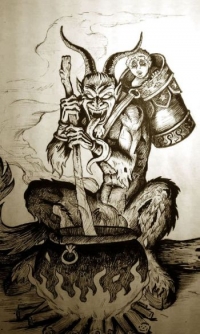The Feast of Saint Nicholas, the Saint of Children, is celebrated in many European countries on the 6th December. The day before is known in Austria as Krampusnacht or Krampus Night, a time when Krampus walks the streets and visits people’s homes to punish naughty children. Krampus is described as half demon, half goat, and has black or brown fur and the cloven hooves and horns of a goat, similar to the Christian Devil. He also has a long pointed tongue which lolls out. He is often depicted carrying chains which he thrashes for dramatic effect. The chains are sometimes accompanied with bells. He also carries bundles of birch branches called ruten, which is significant in many Pagan cultures. In contrast to Saint Nicholas rewarding good children with nice presents, Krampus visits the homes of naughty children and beats them with birch bundles, before leaving them the gift of coal.
‘There seems to be little doubt as to his true identity for, in no other form is the full regalia of the Horned God of the Witches so well preserved. The birch – apart from its phallic significance – may have a connection with the initiation rites of certain witch-covens; rites which entailed binding and scourging as a form of mock-death. The chains could have been introduced in a Christian attempt to ”bind the Devil”, but again they could be a remnant of Pagan initiation rites.’ – The Krampus in Styria, Maurice Bruce, 1958
In traditional parades, known as the Krampuslauf, meaning Krampus run, young men dress as Krampus and parade through the streets. Writing in 1975 about his time in Irdning, a small town in Styria, Austria, anthropologist John J. Honigmann wrote:
‘The Saint Nicholas festival we are describing incorporates cultural elements widely distributed in Europe; in some cases going back to pre-Christian times. Nicholas himself became popular in Germany around the eleventh century. The feast dedicated to this patron of children is only one winter occasion in which children are the objects of special attention; others being Martinmas, the Feast of the Holy Innocents, and New Year’s Day. Masked devils acting boisterously and making nuisances of themselves are known in Germany since at least the sixteenth century while animal masked devils combining dreadful-comic antics appeared in Medieval church plays. A large literature, much of it by European folklorists, bears on these subjects. Austrians in the community we studied are quite aware of “heathen” elements being blended with Christian elements in the Saint Nicholas customs and in other traditional winter ceremonies. They believe Krampus derives from a Pagan supernatural who was assimilated to the Christian devil. The Krampus figures persisted, and by the 17th Century, Krampus had been incorporated into Christian winter celebrations by pairing Krampus with St Nicholas.’
Extract from The Supernatural World of the Anglo-Saxons:
Gods, Folklore and the Pagan Roots of Christmas and Halloween





 del.icio.us
del.icio.us
 Digg
Digg
Les commentaires sont fermés.